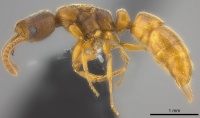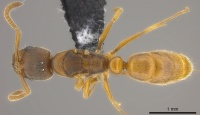Ponera manni
| Ponera manni | |
|---|---|

| |
| Scientific classification | |
| Kingdom: | Animalia |
| Phylum: | Arthropoda |
| Class: | Insecta |
| Order: | Hymenoptera |
| Family: | Formicidae |
| Subfamily: | Ponerinae |
| Tribe: | Ponerini |
| Genus: | Ponera |
| Species: | P. manni |
| Binomial name | |
| Ponera manni Taylor, 1967 | |
The types were collected from under a stone in wet soil on the floor of slightly disturbed rain forest at about 1000 m elevation. Additional collections have all come from relatively disturbed or lowland habitats.
Identification
Taylor (1967) - Size moderately large (head width 0.57 mm); eyes single-faceted, placed well back on the relatively strongly convex sides of the head; petiolar node narrow (petiolar node index 73); antennal funiculus lacking a distinctly differentiated club; mesometanotal suture clearly incised on mesosomal dorsum. This is the only known Ponera species with HW exceeding 0.43 mm, which has a PNI less than 77.
Ponera manni is easily separated from the only other Fijian Ponera of similar size (Ponera colaensis) by the combination of larger size (HW 0.50-0.54 mm in colaensis); relatively broad head (cephalic index 89; 81-83 in colaensis); distinctly incised mesometanotal suture; narrower petiolar node (PNI 86-91 in colaensis); and lighter color.
Keys including this Species
Distribution
Latitudinal Distribution Pattern
Latitudinal Range: -16.583° to -18.217°.
| North Temperate |
North Subtropical |
Tropical | South Subtropical |
South Temperate |
- Source: AntMaps
Distribution based on Regional Taxon Lists
Indo-Australian Region: Fiji (type locality).
Distribution based on AntMaps
Distribution based on AntWeb specimens
Check data from AntWeb
Countries Occupied
| Number of countries occupied by this species based on AntWiki Regional Taxon Lists. In general, fewer countries occupied indicates a narrower range, while more countries indicates a more widespread species. |

|
Estimated Abundance
| Relative abundance based on number of AntMaps records per species (this species within the purple bar). Fewer records (to the left) indicates a less abundant/encountered species while more records (to the right) indicates more abundant/encountered species. |

|
Biology
|
Castes
Nomenclature
The following information is derived from Barry Bolton's Online Catalogue of the Ants of the World.
- manni. Ponera manni Taylor, 1967a: 86, figs. 76, 77 (w.) FIJI IS.
Unless otherwise noted the text for the remainder of this section is reported from the publication that includes the original description.
Description
Worker
Holotype. HL 0.64 mm; HW 0.57 mm; SL 0.47 mm; CI 89; SI 82; PW 0.41 mm; PNL 0.21 mm; PH 0.41 mm; DPW 0.30 mm; PNI 73. Mandibles triangular; outer borders slightly sinuate; masticatory border with 3 strong teeth occupying the apical 2/5 of its length, followed by a series of 7 distinct obtuse denticles, which appear in the worn mandibles of the type to have been subequal in size, and about 1/2 as large as the smallest of the apical teeth. Head as in fig. 76; occipital border moderately concave; sides relatively strongly convex. Leading edge of clypeus almost straight; anterior face with a raised obtuse median longitudinal tumosity. Palpal formula: Maxillary 2: Labial 2 (inspected). Eyes minute, single-faceted, about 0.01 mm in diameter, situated about 0.8 X the distance from lateral occipital border to median anterior genal border. Scapes noticeably more slender than usual in Ponera, almost exactly reaching median occipital border when laid back on head. Funiculus also relatively slender, distinctly expanded apically, but no definite segmental club differentiated ; apical segment about equal in length to the 2 preceding together. Mesosomal profile as in fig. 77. Mesometanotal suture very distinctly marked ; lateral mesonotal suture reduced to a faint vestige. Propodeal sides and declivity almost straight, when viewed from above ; posterolateral edges forming angles of about 90° in dorsal view. Form of node as in fig. 77. Subpetiolar fenestra distinct, oval ; posterolateral teeth acute.
Mandibles smooth and highly polished. Clypeus moderately shining, indistinctly shagreened. Head subopaque, finely and closely shagreened. Scapes moderately shining, very finely punctate. Dorsum of mesosoma fairly strongly shining, with very shallow, somewhat effaced, puncturation. The punctures less than 0.01 mm in diameter, spaced at intervals about equal to their average diameter on pronotum; somewhat closer on mesonotum; those on propodeal dorsum less distinct and more sparsely scattered. Sides of mesosoma more strongly shining than dorsum, with similar but more scattered punctures. The usual longitudinal striation of the metepisternal area represented by weak vestiges of such sculpturation. Petiolar node shining, finely punctate. First 2 gastric tergites feebly shining, with a close cover of moderately large, irregular, pilosity-bearing punctures.
Short fine erect to sub-erect pilosity moderately abundant on mandibles, clypeus, frontal lobes and dorsum of pronotum ; sparse on remainder of head and mesosoma. Similar, slightly longer, pilosity moderately abundant on petiolar dorsum and entire gaster, where hairs on ventum and apex are longest. Fine pubescence fairly abundant on head and antennae, gaster and legs; rather sparse on mesosoma and petiole, except pronotal dorsum and apex of node.
Color dull medium reddish brown, legs and gastric apex slightly paler.
Type Material
Holotype in Museum of Comparative Zoology collection (Type No. 30924).
FIJI IS.: Viti Levu: Mt Lomolaki, near Nandarivatu, 17.II.1962 (R. W. Taylor, acc. 22).
The unique holotype was taken under a stone in wet soil on the floor of slightly disturbed rain forest at about 1000 m elevation.
Etymology
This most unusual species is named for the late Dr W. M. Mann, a pioneering myrmecologist in Eastern Melanesia.
References
- Sarnat, E. M.; Economo, E. P. 2012. The ants of Fiji. University of California Publications in Entomology 132:1-384. PDF
- Taylor, R. W. 1967a. A monographic revision of the ant genus Ponera Latreille (Hymenoptera: Formicidae). Pac. Insects Monogr. 13: 1-112 (page 86, figs. 76, 77 worker described)
References based on Global Ant Biodiversity Informatics
- Sarnat Eli M. 2009. The Ants [Hymenoptera: Formicdiae] of Fiji: Systematics, Biogeography and Conservation of an Island Arc Fauna. 80-252
- Taylor R. W. 1967. A monographic revision of the ant genus Ponera Latreille (Hymenoptera: Formicidae). Pacific Insects Monograph 13: 1-112.
- Ward, Darren F. and James K. Wetterer. 2006. Checklist of the Ants of Fiji. Fiji Arthropods III 85: 23-47.


